
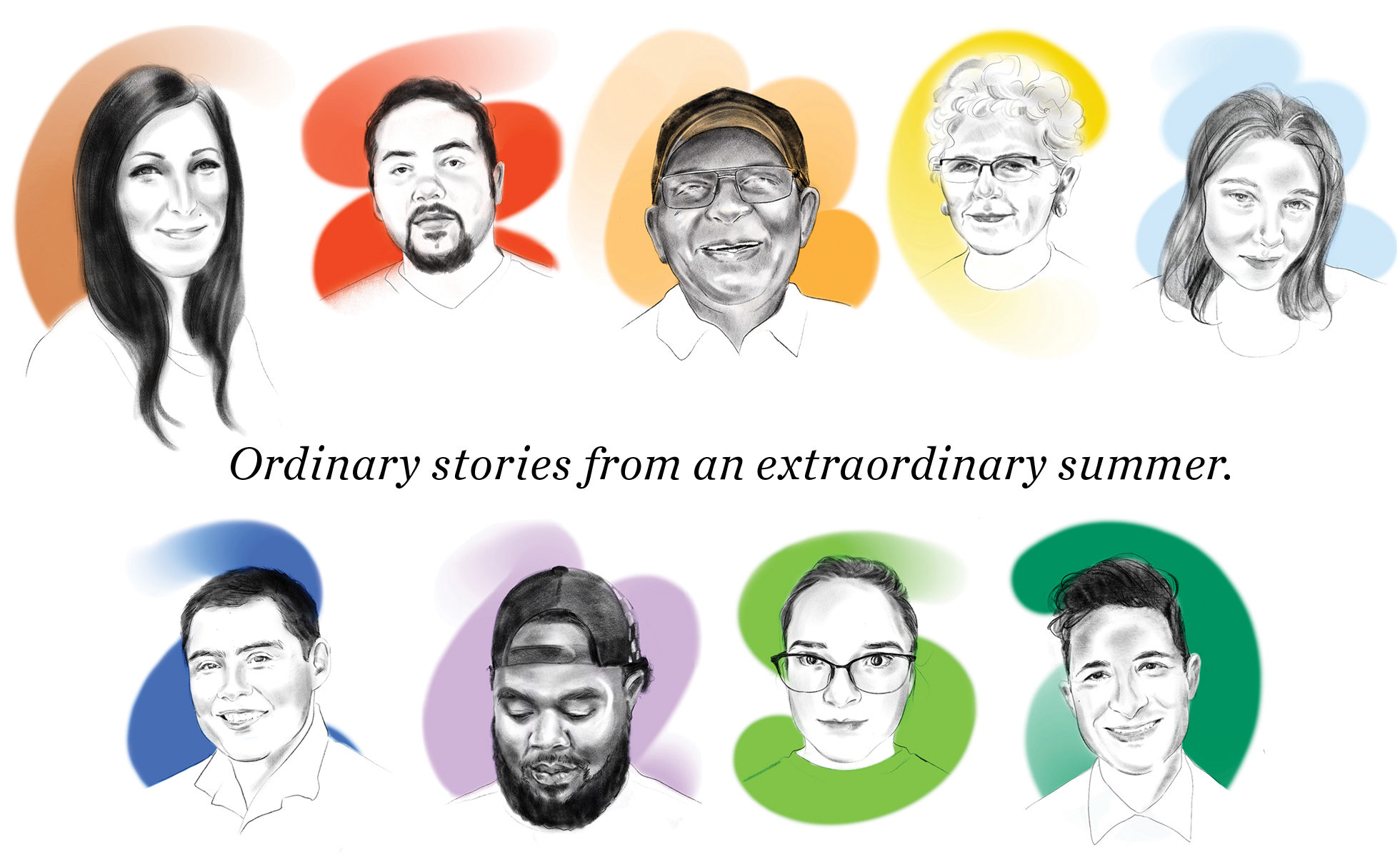
By Texas Observer Staff
Illustrations by Lindsay Mound
August 31, 2020—Nearly six months into the COVID-19 pandemic, more than 600,000 Texans have been infected. As of late August, more than 12,000 had died. Total cases and deaths more than doubled from July to August. For several weeks this summer, hospitalizations broke records daily. We hear these numbers a lot. For each, there are the people who care for them, hope for them, mourn them. There are people who lost their jobs, who miss their family, who worry about their kids, who don’t know how they’ll make it. These are ordinary people dealing with extraordinary circumstances. These are some of their stories.
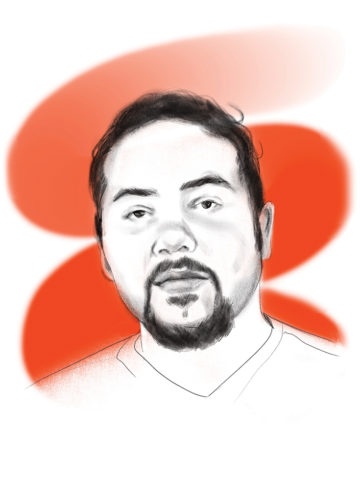
Name: Michael Saenz
Age: 35
Profession: Radiologic technologist
Location: Mount Pleasant, Titus County
Michael Saenz measures the time he was sick in relation to Mother’s Day and Father’s Day. On May 15, the Friday after Mother’s Day, his cough started. His temperature rose steadily over the next few days. That Tuesday, Saenz, a 35-year-old X-ray technician at a rural hospital in Northeast Texas, tested positive for COVID-19, likely caught from a patient at work. Just over a month later, shortly before Father’s Day, he felt lucky to be alive.
Saenz remembers only parts of the weeks in between. After several days quarantined at home, he began to hear a crackling sound in his chest when he exhaled and went to the emergency room at Titus Regional Medical Center, where he works. “It’ll take your breath away, literally,” he says of COVID-19. Doctors increased his supplemental oxygen fivefold overnight, but Saenz’s condition continued to deteriorate. He remembers being taken out of the hospital on a stretcher, past coworkers cheering him on. He remembers the ambulance pulling over en route to the Tyler hospital where he was being transferred. An EMT from Titus had chased them down to administer plasma treatment, just then ready, on the side of the road. “I’m pretty sure if he didn’t catch us to give me plasma, we wouldn’t be having this conversation,” Saenz says.
The last thing he remembers is talking to his wife from his ICU bed in Tyler. Then he was sedated and placed on a ventilator for more than a week.
Being separated from his family was the hardest part of getting sick, Saenz says. “I kept telling myself that I was going to come back home, that my son needed me.” FaceTiming with family “kept me sane,” he says. “You’re there on your own: no family, no one there, no support.” There were a few moments, he says, when “I did want to just throw in the towel. But I told myself, ‘I’m going back.’”
On Father’s Day, Saenz was finally able to see his wife and 2-month-old son again. “That was a bit emotional, being my first Father’s Day, being able to go hold my son,” he says.
When he returned home, Saenz learned that a 58-year-old coworker had been put on a ventilator around the same time he had. The other man died. “It was shocking when I found out,” he says. “It was somebody who I would see every day, say hi to every morning.”
On June 29, Saenz was welcomed back to work at the hospital with a drive-by parade in the parking lot. Since then, COVID-19 cases have risen dramatically. Titus’ ICU was full for several weeks in July, and transfers of critically ill patients were stymied by larger metro hospitals running out of space too. Although he’s COVID-19-negative, Saenz is still recovering—standing and walking around tires him out easily now, and he was still in physical therapy more than a month after he was discharged. “I’d been after my parents to be careful, for them to be safe, and I’m the one who ends up in the hospital,” he says. “I don’t have any underlying conditions, and it knocked me out.” —Sophie Novack
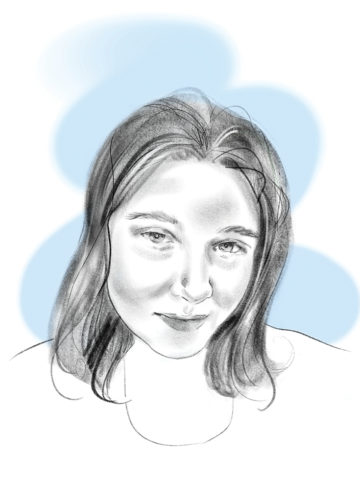
Name: Julie Easterling
Age: 38
Profession: Unemployed
Location: San Marcos, Hays County
Julie Easterling was ready to give up. She had spent three hours on hold one afternoon in mid-June, desperately trying to reach someone at the Texas Workforce Commission (TWC), the state agency that administers the unemployment benefits she’s relied on throughout the pandemic. By the time Easterling, a single mom, finally got through, it was just 15 minutes before the call center closed at 7 p.m. She managed to say “Hello?” before she heard a click and the call ended. Within days, her benefits were cut off.
“I have a 2-year-old, I’m eight months pregnant, and I have nothing,” she says. “I don’t know what to do.”
Before the pandemic, Easterling ran her own business hauling junk in Central Texas. She first started doing hauls last summer when she was homeless, to pay for a hotel room for her and her son. But when the COVID-19 state lockdown went into effect in March, the work dried up and her business shuttered. A self-employed worker like Easterling typically wouldn’t qualify for unemployment benefits, but the Coronavirus Aid, Relief, and Economic Security (CARES) Act temporarily expanded access through the end of the year, allowing her to collect $650 each week since late April.
But on June 16, Easterling received a notice from TWC that her unemployment claim had come under review and the agency needed more information. If she didn’t respond within seven days, the agency warned that it could delay or deny her benefits. Panicked, Easterling called TWC’s 1-800 line but got no answer. Several times a day she called, but no one ever picked up. The voicemail was full. Her emails went unreturned. The agency’s phone lines and web servers have been completely overwhelmed by the historic surge of Texans who lost their jobs due to COVID-19.
Over the next week, Easterling sat on hold for hours on end, while trying to wrangle her toddler. The deadline to respond came and went and she still hadn’t gotten through. Finally, she got another notice from TWC saying that she would no longer receive benefits because she “did not contact us as requested to provide information about your claim.”
“It’s just gut-wrenching,” says Easterling, who worries the stress will cause complications with her pregnancy. “What are we supposed to do? Nobody knows.”
Before she became eligible for Medicaid during her pregnancy, Easterling was one of the millions of Texans without health insurance. (More than 650,000 people in the state have lost health coverage along with their jobs during the pandemic.) She doesn’t know when that coverage will end; pregnant Texans normally lose Medicaid 60 days after giving birth, but during the COVID-19 federal disaster declaration, enrollees can’t be kicked off their coverage.
Easterling missed out on at least $2,600 in benefits while waiting to sort out her unemployment claim this summer. Without any income, she won’t be able to pay rent for her San Marcos apartment and worries her family will be kicked out. “I can’t afford an eviction. I have nowhere to go,” says Easterling. “I’m scared to death.”
Then, in early August, a week before she was due to give birth, TWC sent another notice: Because Easterling hadn’t registered her business with the state, it said, she was never actually eligible to receive the benefits. The agency ordered her to pay back all the money she had received. —Justin Miller
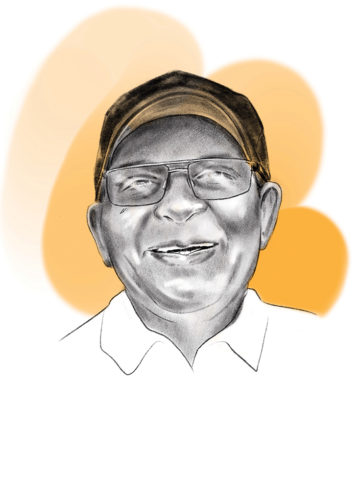
Name: James Cleophas Campbell
Age: 88
Profession: Retired truck driver
Location: Houston, Harris County
When James Cleophas Campbell felt fatigued in mid-March, his family expected a quick recovery from what seemed like the common cold, or maybe the flu. James C., an 88-year-old World War II veteran and retired long-haul truck driver, was healthy and strong. His parents had lived into their late 90s. And at the time, it was mostly international travelers who were catching COVID-19. James C. and his wife, Rosa, had gone no further than their church, the doctor’s office, and the grocery store.
Then James C. began struggling to breathe. Rosa, a retired registered nurse, called 911. Twice medics came and treated him at home. But she hesitated at first to let them transport her husband to the hospital after paramedics told her that based on his symptoms, he’d likely be assigned to the coronavirus ward, where no visitors—even his wife of 68 years—were allowed. Finally, on their third visit on March 23, she let them take him away.
James C. tested positive for COVID-19 at Baylor St. Luke’s Medical Center. Doctors tried hydroxychloroquine, the anti-malaria drug that’s unproven for COVID-19. It didn’t help. Then, after eight days on a ventilator in a medically induced coma, he died on March 31. “He literally died in isolation, and that’s the hard part,” says his son, James T. Campbell.
As a former journalist and executive at Blue Cross Blue Shield of Texas, James T. was already well-informed about pandemics and public health. After his father’s death, the fight against COVID-19 got personal. He’s angry about how many Texans don’t bother to wear a mask even while grocery shopping—one of the places his dad may have been infected. And he’s struck by how the virus has disproportionately affected African Americans like his father. For months, state health officials failed to report complete race or ethnicity data, but death certificate data released in late July confirmed that Black and Hispanic Texans are dying at higher rates than other groups.
James T. still mourns the man he calls “the original James Campbell.” He and his four sisters, all masked, took their mother to visit their father’s grave for the first time on June 20, after the veterans’ cemetery reopened. On the Fourth of July, he posted a photo on Facebook of the barbecue ribs, chicken, and sausage he’d prepared on his father’s monstrous backyard “grill gizmo,” he wrote. “I hope I honored him.”
No one else in the Campbell family has tested positive. James T. remains focused on making sure his 85-year-old mother stays safe. He’s usually an optimistic person, but as the pandemic stretches on and on, so does his grief. “Now we are 150,000 [deaths] in and we know a lot more about it and the treatment protocols, and we just need the science to catch up,” he says of the national COVID-19 death toll in late July. “But we’ll never forget this. Not for the rest of our lives.” —Lise Olsen
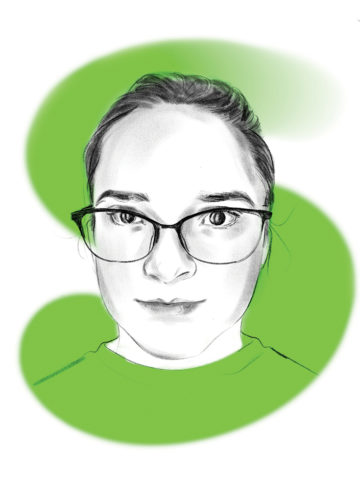
Name: Erin Tolman
Age: 43
Profession: Teacher
Location: Arlington, Tarrant County
Each morning, Erin Tolman wakes up, gets her two kids fed and situated with their schoolwork, and tries to focus on her own lessons from home. For the past few months, Tolman, who teaches seventh grade math and high school health science, has juggled home-schooling her own kids, who have disabilities, with creating virtual courses for her students. She does all this as quietly as possible: Her husband, a home health aide, works nights, and she tries not to wake him.
Tolman worries that students have already fallen far behind, a concern that’s amplified for her own children. The family has one computer for the two kids to share. Her son, 9, struggles with reading, so she needs to help with his work online. Virtual learning has been “a disaster” for her daughter, 13, who was in a functional academics class that Tolman says can’t really be done online. “The reason I would never choose to home-school is because I can’t meet the needs of my kids,” she says. “It is hard when my dyslexic son gets frustrated. It is hard for my daughter, who is intellectually disabled, to understand,” Tolman says. “With her disability she does not handle changes in routine.”
A series of cancellations have been challenging: Church moved online, and Tolman misses the community she considers family. Birthday parties for both kids became small family celebrations. Her son had been rehearsing for a school musical for months before it was canceled in May. Their summer camps closed. The community pool closed. The baseball game Tolman planned to take the kids to in June was canceled. “Luckily I didn’t tell them about that,” she says. “So I didn’t have to disappoint them.”
The stress has taken its toll; Tolman’s doctor recently prescribed a second antidepressant. Tolman has grappled with whether she and her kids should go back to school in the fall. “Putting myself at risk and putting my family at risk, and now weighing that with the benefits of school and my livelihood—it’s stressful,” she says.
Tolman is most worried about her husband, who is diabetic and survived a major heart attack in January, one dubbed the “widow-maker” because of its high mortality rate. She switched school districts this year, cutting her commute from 45 minutes to 10, to spend more time with family and be closer in case of another emergency. “COVID really does scare me. And I really think that my husband could die from it,” she says. “So I’m kind of just trying to prepare for worst-case scenarios.” —Sophie Novack
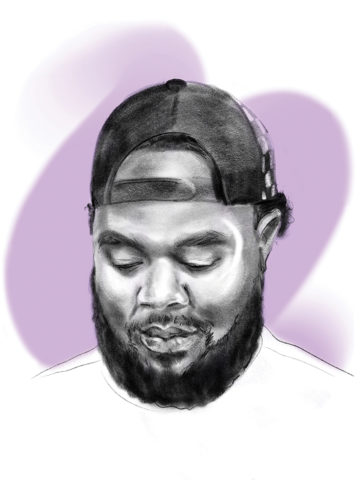
Name: Calvin Abbott
Age: 32
Profession: Chef
Location: Dallas, Dallas County
As his income began to unravel this spring, Calvin Abbott wasn’t initially worried. He figured he would eventually be able to find work and get some government assistance to keep his apartment in North Dallas.
Abbott, a private chef and caterer, started losing corporate clients as early as February, as people stopped traveling for business. From there, it went downhill fast. He’d been the catering manager for the University of North Texas at Dallas, but soon there was no one on campus to feed. Weddings were called off, private events postponed.
He applied for unemployment benefits but was denied twice. In late April, the City of Dallas approved $13.7 million for short-term rental and mortgage assistance for people who had been affected by COVID-19 shutdowns. Abbott applied just hours after the program launched, on May 4. “I have all the paperwork to show that I have no income,” he says. “So I figured that I was in a good position to at least get rental assistance.” He told the manager at Oasis Apartments, where he pays $710 for a one-bedroom, that he’d lost his job and had applied for help from the city.
Every few weeks, he was told his application was being processed, that he was close to being approved. Then, in early June, Oasis sent a notice to vacate. “Out of nowhere, I was served with eviction papers,” Abbott says. “It blew my mind.”
He went to court to fight the eviction, but by the time a judge ruled against him on June 8, Abbott owed $2,200 in back rent. As he scrambled to pull together the cash, borrowing from family and friends, his landlord said that he’d have to pay an additional $1,500 in late fees that had accrued since March in order to stay in his apartment.
Unable to pay, Abbott got in touch with Mark Melton, an attorney who has recruited hundreds of lawyers to offer pro bono legal help to Dallas renters facing eviction during the pandemic. Melton told Abbott that his property was protected under the CARES Act, which prohibited landlords from filing for eviction or charging late fees on missed rent at properties that benefit from federal subsidies until July 25. (According to the National Low Income Housing Coalition, Oasis Apartments has a federally backed mortgage.) Abbott learned that his landlord was one of hundreds across Texas who had filed evictions in violation of the CARES Act.
More than two months later, Abbott is still waiting for his eviction appeal to be scheduled. He’s still waiting to hear if he’s approved for rental assistance. “I’m still kind of in a weird situation,” he says. Stuck at home, waiting to find out if he can stay. —Megan Kimble
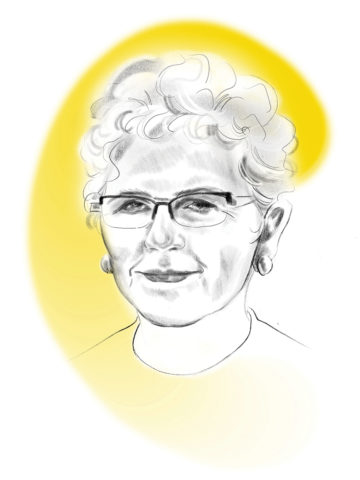
Name: Betty Gibson
Age: 82
Profession: Retired bookkeeper
Location: Wichita Falls, Wichita County
In early March, 82-year-old Betty Gibson took a trip with her daughter and two of her granddaughters to Broken Bow, Oklahoma, a resort town across the border from Clarksville in Northeast Texas. “We just had the best time,” she says, staying in a cabin and roasting marshmallows in the fire pit. By the time she got back to her hometown of Wichita Falls, COVID-19 had started to spread through the state. Heeding the advice of public health officials, Gibson isolated herself in her home on her return. She hasn’t seen much of anyone in the six months since. Now she views their last vacation as “a farewell trip for me and my family.”
Before the pandemic, Gibson saw her family a couple times a week. The Gibson clan sprawls throughout Texas. One of her sons lives in Burkburnett, just north of her; another lives in Amarillo; her daughter is in Midland. She has seven grandchildren and 12 great-grandchildren. It’s just too risky to visit them now. The pandemic has turned what Gibson describes as “a real huggin’, kissin’ family” into one that has no physical contact. “That’s the hardest thing in the world, to not be able to hug somebody,” she says. “Sometimes you kind of forget what it’s like to touch somebody.”
Gibson says the last time she felt this isolated was 60 years ago, when her husband enlisted in the Army and their young family moved to Germany. Shortly after, her husband was sent to Lebanon, and Gibson and their toddler were left alone in a foreign country. Still, she considers herself more fortunate than many elderly Texans now. She’s able to live at home, after all, instead of in a nursing home where COVID-19 has spread rapidly. And she is able to take comfort in her three dogs. “They are a lot of company,” she says. “I would not like to be without them, especially right now.”
Gibson gets out of the house only when absolutely necessary. When she does, she’s careful to wear a mask, even when picking up her groceries curbside. She keeps a journal of her limited daily interactions, just in case she gets sick and officials need to trace the infection.
Gibson has made only one major exception to her isolation: a trip to the hairdresser. In early June, she ventured to her stylist, who wore a face mask and allowed only one customer at a time. It was her first haircut since February. “That was a real, real big deal for me,” says Gibson, who takes great pride in her carefully coiffed gray hair. Despite the risk, it felt good to do something ordinary, even if she had to go to extraordinary lengths to do it. “I may not put on makeup every day, but I want my hair to look decent,” she says. “It’s the only thing that seems near normal.” —Christopher Collins
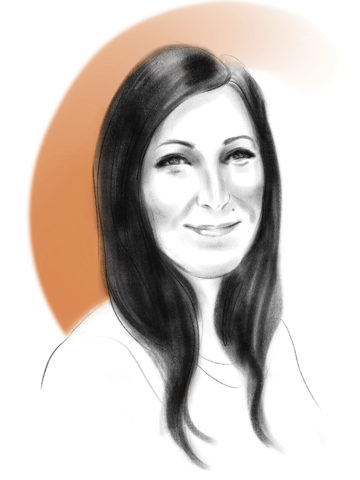
Name: Lauren Byrd-Moreno
Age: 28
Profession: Nursing student
Location: Beaumont, Jefferson County
Lauren Byrd-Moreno hasn’t seen her husband, Christopher Crain, since February. For about a month this spring, they couldn’t speak at all. As COVID-19 cases rose across Texas prisons, Byrd-Moreno was completely cut off from Crain, who is incarcerated in the Clemens Unit in Brazoria. She didn’t know whether others in his unit were infected, or whether her husband was sick.
In mid-March, the Texas Department of Criminal Justice suspended all visits to its prisons in an attempt to prevent the virus from spreading. In late April, the Clemens Unit was placed on lockdown when an inmate tested positive. Before the pandemic, Byrd-Moreno could have called Crain daily to talk for at least 30 minutes. But during the lockdown, which lasted well into May, phones were off-limits to inmates, who were quarantined in their cells.
When Crain started running a low-grade fever in early May, Byrd-Moreno didn’t hear about it until she received a letter from him a week later. “Baby, idk what’s going to happen,” Crain wrote. “I am not feeling too good and I am not sure what [the medical staff] are going to do with me.” Inmates who contracted COVID-19 were moved to isolation wards. “So if you don’t hear from me, that’s probably why,” he told her.
Byrd-Moreno turned to the prison’s medical hotline, desperate for information. She was told that Crain didn’t currently have COVID-19 symptoms but that he hadn’t been tested. “By the time I found out [about his fever], it was like, if anything had happened, how would I have known?” she says.
With contact limited and mail slow to arrive, Byrd-Moreno and thousands of other Texans with loved ones behind bars are largely left in the dark about the health of their family members. That’s as more than 15,000 Texas inmates have tested positive for COVID-19 as of August, and more than 100 died.
For Crain, too, the fear of COVID-19 is compounded by the isolation. “Not being able to talk to our loved ones in the middle of the pandemic made stress sometimes seem unbearable,” Crain wrote in a letter to the Observer.
In July, Crain was able to make regular phone calls to his wife. But he says that people are still testing positive for COVID-19 in his prison, and Byrd-Moreno is bracing for a period of radio silence again if the unit goes into another lockdown. “You never know when it’ll all get turned off if someone tests positive,” she says. “That’s just the nature of the beast.” —Amal Ahmed
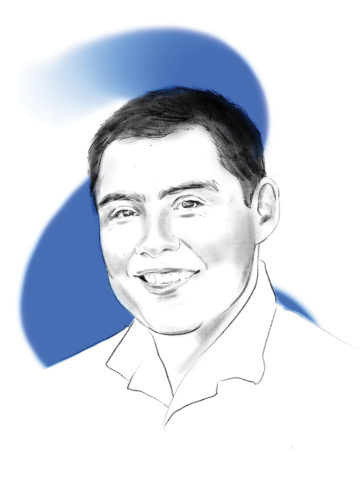
Name: David Ceron
Age: 43
Profession: Author
Location: McAllen, Hidalgo County
This summer, David Ceron finally found a place where he could see his mother without a window between them: the parking lot of her dialysis clinic in Mission, on the Texas-Mexico border. Gregoria Ceron was hospitalized for kidney failure in May and now has to visit the clinic three times a week—her first trips out of her nursing home since it was closed to visitors in March. David comes by one evening each week to see her as she gets out of her appointment. There, the paramedics let him stay and talk with her for a few minutes before they place her stretcher into the ambulance to drive back to the nursing home.
On one of his earliest visits, Gregoria, who recently turned 90, reached out her hand to David, who was standing a few feet away. She lay with her eyes closed, a mask covering much of her face, her body wrapped in a lavender medical gown and strapped into the stretcher. He froze. “She reached out to me with her hand, and I couldn’t grab it—just to be safe,” David says. “She didn’t understand why, and it broke my heart. And I said, ‘You know what, if she does that again, I’m going to just grab her hand.’”
This summer, as COVID-19 cases surged across the Rio Grande Valley where they live, David has seen the rise mirrored in his family. Three of his sisters tested positive for COVID-19. One sister, who has diabetes, lost her sense of taste and smell and was almost hospitalized. Another sister, her husband, and her 5-month-old son all tested positive, and David’s brother-in-law was hospitalized.
“It almost seems like from one day to the next, things were kind of in control, to all of a sudden, it just blew up,” David says of the situation in the Valley. “[Hospitals] are just being inundated by all these patients coming in. … And it’s very scary now because, you know, what’s going to happen if one of us gets really sick?”
Several family members work at local hospitals that are overrun with COVID-19 cases, where David worries they’ll be infected. He worries most about Gregoria and another sister, Carmen, both of whom have diabetes and need dialysis.
In May, David and some of his siblings gathered outside Gregoria’s nursing home window to celebrate Mother’s Day and her birthday. David says the pandemic has been especially hard on her emotionally; she’s used to seeing family every day and doesn’t understand why she can’t now. Once, in the parking lot of her dialysis clinic, she asked David why he doesn’t visit her anymore, and a paramedic started to cry. David tries to reassure her that the family will be together again soon. But he doesn’t know when that will be. He promises that when this is all over, they’ll visit the beaches in Nayarit, Mexico, where she was born. And now when she reaches out her hand, he takes it. —Sophie Novack
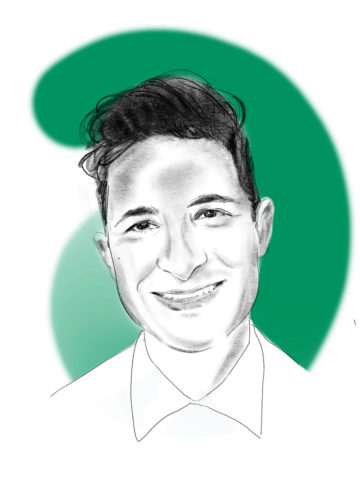
Name: Clint Hebert
Age: 41
Profession: Funeral director
Location: The Woodlands,
Montgomery County
Clint Hebert doesn’t like to say no. He likes to say yes and. That’s been difficult as a funeral director during the COVID-19 pandemic, when public health concerns have dramatically limited the size of services and made many mourning traditions impossible. But Hebert—a soft-spoken man with a subtle Texas drawl—has done what he can to appease the many families who have lost loved ones, to the virus or otherwise.
For the family of the man who loved Blue Bell ice cream, Hebert arranged a memorial service with single-serve, individually wrapped portions of ice cream for the few people in attendance. For the family who’d hoped for a large gathering, Hebert bought 300 pink balloons and filled the pews of his chapel with them to represent the people who couldn’t be there. For many others, Hebert has facilitated drive-by parades, where cars pass a gravesite and honk their horns in solidarity.
“We always say we’re family taking care of family, especially with the folks who are in our community,” says Hebert, the general manager of Forest Park, a funeral home and cemetery in The Woodlands, a Houston suburb. He struggles with the distancing required during the pandemic: masking his face to the people who come to his door, arranging modest ceremonies for families he set elaborate services for years earlier, refraining from hugging or shaking hands with the bereaved. “For them to put their loved one in our care, for us to get into that intimate part of their life, it takes people letting their walls down,” he says.
In July, the bodies started piling up in Texas. Morgues in the Rio Grande Valley and parts of Houston saw two of the biggest surges, according to the Texas Funeral Directors Association. Officials across the state scrambled to get morgue trucks where they were most needed, and many counties ordered extra body bags. As cases skyrocketed, death-care professionals braced for a deluge.
Hebert has not yet seen the influx of bodies that directors in South Texas and parts of Houston have, but he’s still dealt with families at a steady clip. There are fast times and slow times in the funeral industry, he says. This is not a slow time for anyone. —Sunny Sone
Read more from the Observer:
Texas Already Lacked Affordable Child Care. Then COVID-19 Hit: The coronavirus has temporarily or permanently closed almost half of all child care providers in the state, leaving few options for low-income working families.
Marsha Jackson Is Trying to Move Shingle Mountain: The illegal dump is southern Dallas’ most visible environmental justice crisis. It’s far from the only one.
The Coronavirus Pipeline: U.S. deportations of migrants have exported COVID-19 to Guatemala and prompted fear, chaos, and a collapse of already fragile health services.







